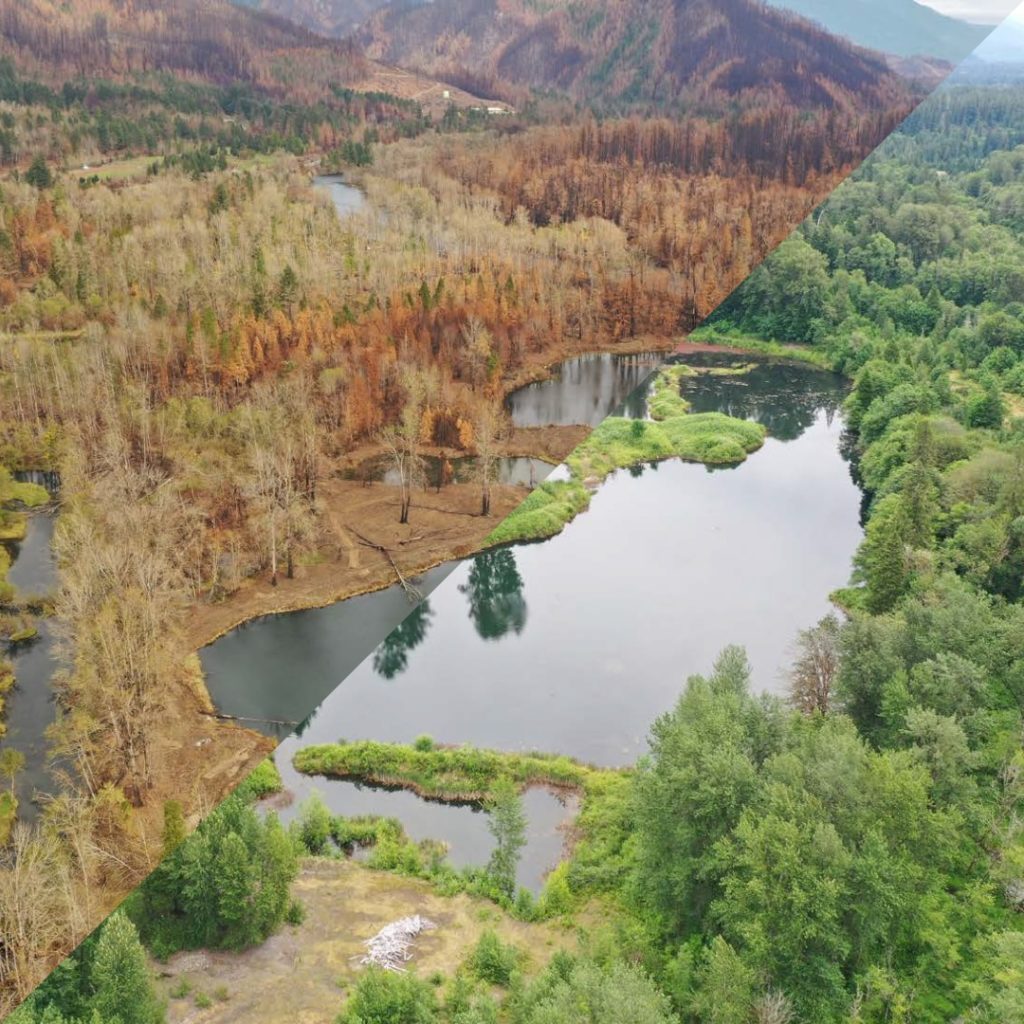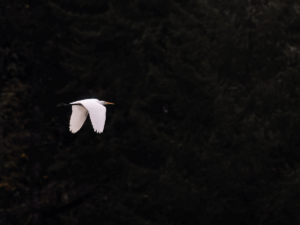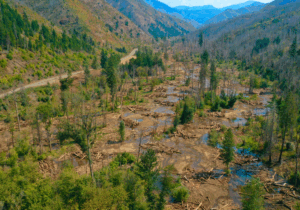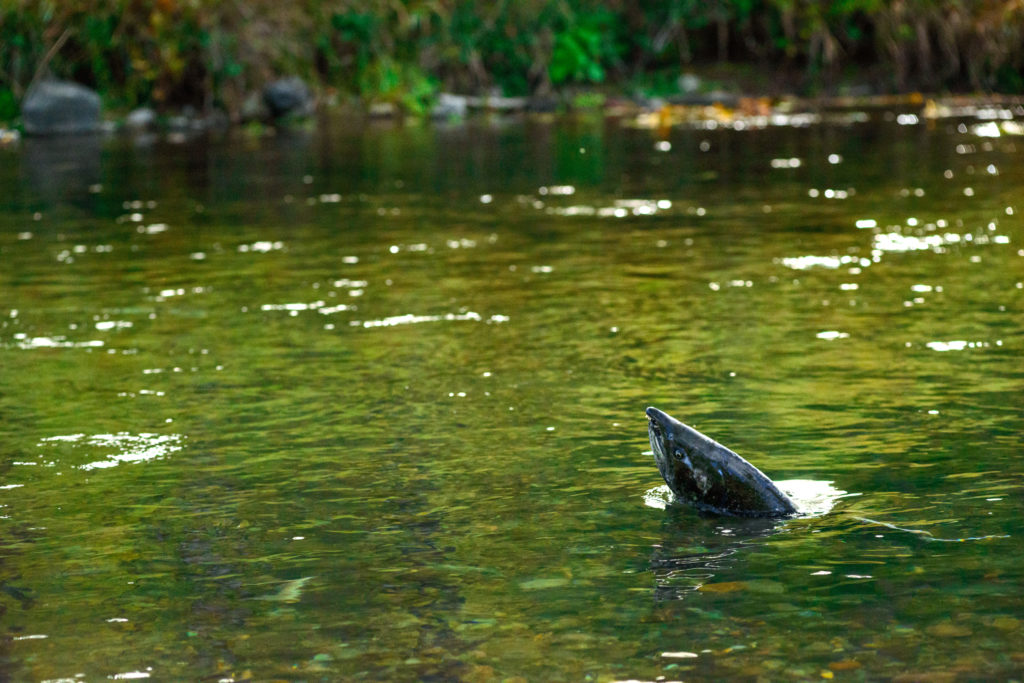September 16th, 2021
One year after devastating wild fires and a summer of unprecedented drought, the first Spring Chinook salmon have arrived at their spawning grounds in the McKenzie River near the Finn Rock Reach restoration project to complete the cycle of life for this iconic species.
“The return of salmon to the area is a powerful testament to their incredible determination, and to the importance of restoration work in our region,” said Joe Moll, Executive Director of the Trust. “Their arrival provides a boost for everyone hard at work in restoration, including efforts on behalf of the human communities that have been challenged by fire and drought.”
McKenzie River Trust completed the first Phase of a floodplain restoration project at Finn Rock Reach, a property owned and managed by the Trust just downstream from the town of Blue River. This initial phase of restoration, completed August 31st, transformed 85 acres of floodplain forest into an intricate network of channels, islands, and wetlands.

“The Finn Rock project is modeled after the floodplain restoration project recently completed on the South Fork McKenzie River, where we’ve seen huge increases in rearing and spawning habitat for salmon, trout, and lamprey,” explained Kate Meyer, a Fisheries Biologist for the U.S. Forest Service. “The USFS is excited to partner with McKenzie River Trust on this project as it complements completed work and planned future work to restore floodplain connectivity to the Middle McKenzie Valley and help recover Chinook and bull trout populations.”
Projects like this also help to protect drinking water, especially after large-scale fires, such as the Holiday Farm fire that burned through the area in 2020. According to Karl Morgenstern, the Watershed Restoration Program Manager for EWEB, “One of the main strategies for buffering the impacts to drinking water quality from these large, burned landscapes is to implement floodplain restoration projects like the McKenzie River Trust is doing at Finn Rock Reach. These projects allow the river to reconnect with its historic floodplain and spread out the flow of water. This reduces river flow velocities, allowing sediment to drop out while decreasing levels of nutrients, metals, and organic carbon that are being mobilized off the upstream burned landscape during storm events.”

Now that the first phase of restoration is complete, McKenzie River Trust staff and partners are tracking the return of Spring Chinook Salmon who utilize the area annually for spawning and rearing habitat.
Returning to the area in early September, salmon were greeted with a very different habitat. The project increased available spawning habitat on site by more than 50% through moving more than 100,000 cubic yards of rock and soil in the project area.

The project also included the addition of thousands of pieces of large wood, many of which was recovered from hazard tree removal projects in the region after the Holiday Farm fire. The addition of large wood provides shelter to several fish species and creates rearing habitat for fish, which is the greatest limiting factor for Spring Chinook in the McKenzie Basin. Additionally, large wood can spread and slow the movement of water, providing essential support in storing gravel in the project area. Gravel is necessary for fish nesting, or redd creation. The addition of large wood back into tributaries and streams is critical for the long-term recovery of salmon in the Pacific Northwest.
The $1.4 million restoration project is funded by committed community partners and donors including the U.S. Forest Service, the McKenzie Watershed Council, the Eugene Water & Electric Board, the Bureau of Land Management, the Oregon Department of Transportation, the Bonneville Power Administration, the Oregon Watershed Enhancement Board, BCI Contracting Inc., Wolf Water Resources, and the McKenzie Homewaters Campaign donors made this project possible.
McKenzie River Trust is actively planning for the second phase of restoration, which will likely take place during the summer of 2023. To ensure public safety and protect multiple threatened and endangered species that make their home in the restoration project area, unguided public access is not allowed.
More Posts to Explore

Public Notice: McKenzie River Trust Seeks Accreditation Renewal
McKenzie River Trust is pleased to announce it is applying for its third accreditation renewal through the national Land Trust Alliance. The land trust accreditation program recognizes land conservation organizations that meet national quality standards for protecting important natural places and working lands forever. The public is invited to comment through Monday, December 22nd, 2025

Caring Across Time
More than four years ago, McKenzie River Trust expanded our work into Lincoln County to help safeguard this special place. Now, we’re carrying forward the good work of the Central Coast Land Conservancy and expanding impact across the Yaquina River watershed.

Partnerships at Work in the McKenzie Valley
The completion of restoration at Quartz Creek bolsters a growing network of efforts to protect water and wildlife across the McKenzie River watershed.







